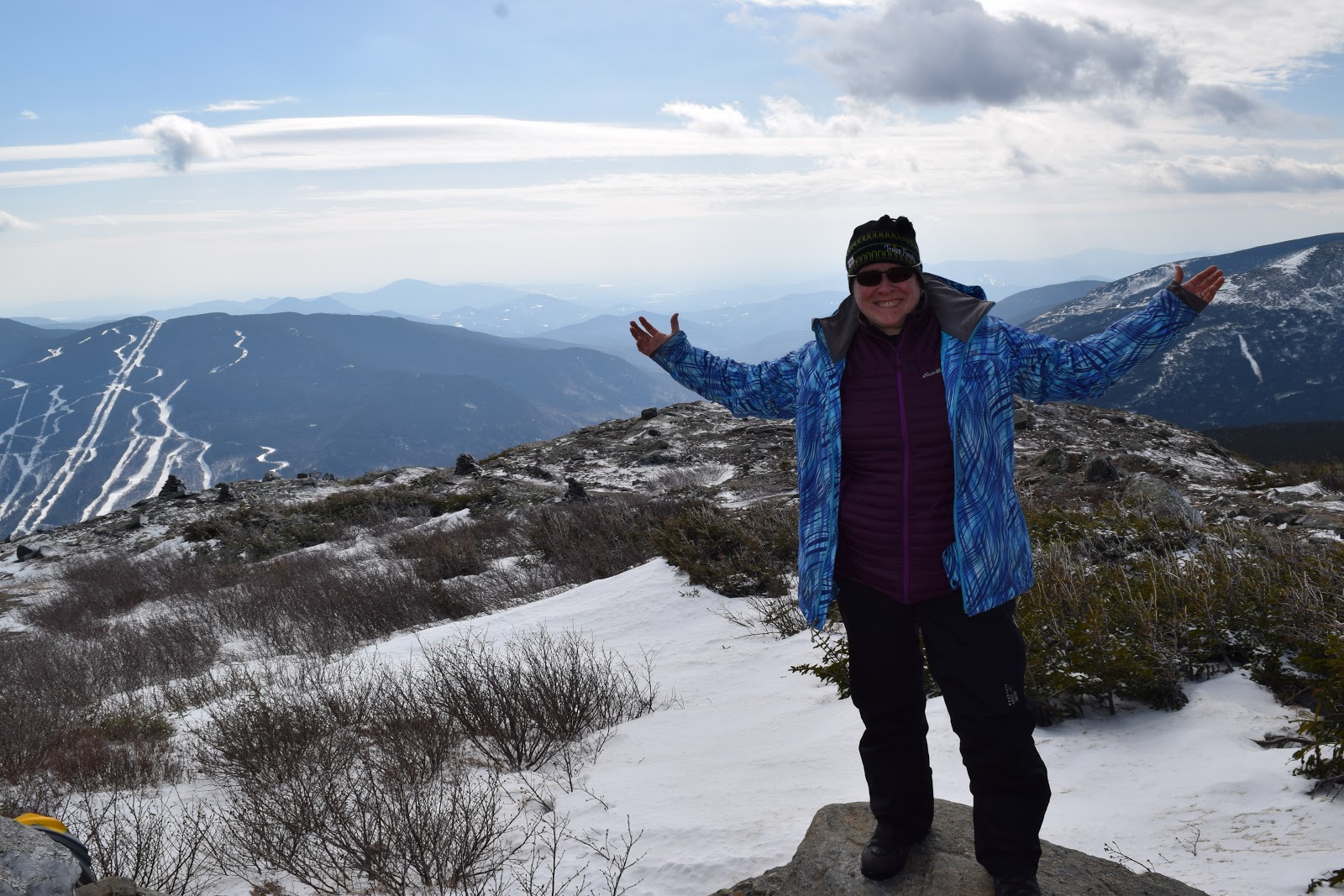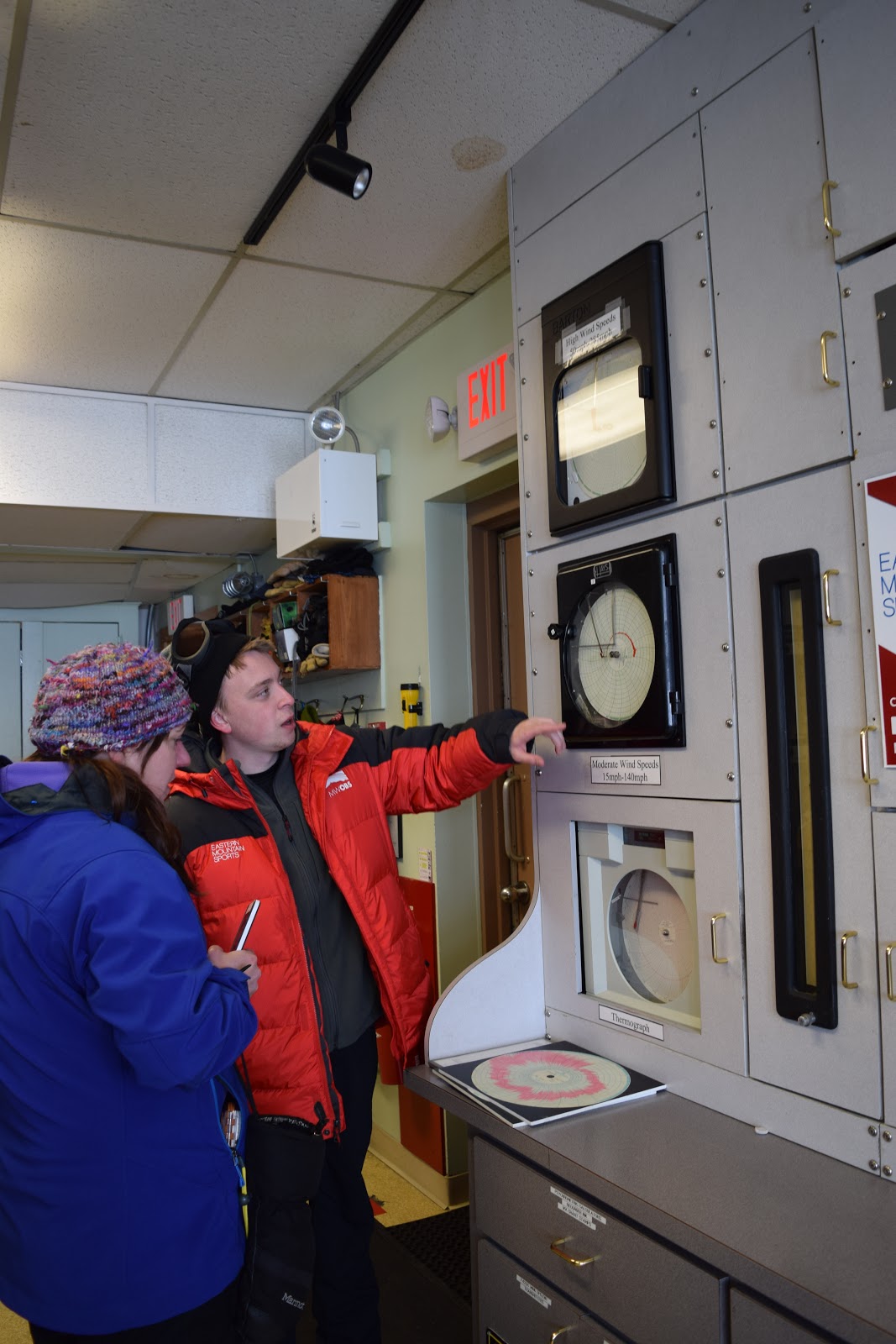Week 4 Post-Trip Report
Mt Washington Arctic Wednesday Trip Post-Blog. K.Mathison .03.01.17
Lao Tsu once said “every journey begins with a single step”. For Colleen Koroski, fellow teacher, and myself, that meant driving to the base of Mount Washington to embark on a “bucket list” trip. Able to blend our love of mountains, teaching, and meteorology, we had the opportunity to travel up to the summit-- 6,288 feet. Excited and ready to go, we headed up the mountain.
Excellent visibility, blue skies dotted with a few clouds and mild temperatures (40ish degrees) allowed us an open window for travel. Our regularly scheduled trip up had already been postponed several times and we were worried we wouldn’t have the chance to go up. Joined by volunteer cooks, summit meteorologist - Tom, observer - Taylor, tech - Adam, summit intern - Nate, and also president, Sharon Schilling-- we headed up the mountain. Talking with fellow travelers about their perspective of what makes the MWOBS so awesome and insight into their individual jobs made the ride up both informative and interesting. It is evident the staff and volunteers are passionate about what they do. Hearing stories of life “on the rockpile” gave us an understanding we hadn’t had before of how treacherous and unpredictable life can be, but also fulfilling and fun.
Stopping at about 4,000 feet for the spectacular views (and a driver switch) gave us the opportunity to take readings on our borrowed Kestrel weather instrument. No measureable wind and 41 degrees Fahrenheit made it a rare “fifty cent day” on Mt. Washington. We basked in the sun as we took pictures of the layered views.
We motored up in the snowcat as the skillful drivers kept us safely on the road even when it seemed too narrow for such a wide vehicle. Views of Wildcat Ski Area, the tiny parking lot we started from and the length of the valleys, both north and south were phenomenal. To say it was more than we expected would be an understatement. Yes, we were overdressed, but better to have all the safety gear for the unpredictable turn of weather Mt. Washington is so famous for. “No such thing as bad weather, just bad gear” and maybe bad choices too… Best to be prepared for anything. Colleen shared her third grade students’ wind chill packet with Tom and other passengers as rode up. Students were insightful and Tom and Sharon were impressed by the work the students had done. 
We stopped again at about 5,400 feet and got out to stretch our legs and admire the views. We took more Kestrel instrument measurements-- low wind and slightly cooler, pressure dropping. Vegetation was down to a few trees, only those that adapted to severe and variable conditions survived. The first view of the summit towers, ravines, and south valley showed us our final destination. Learning a short geology lesson about the rock formations and age of rocks gave us insight into the formation of the mountain itself. We piled into the snowcat for our final leg to the summit. Best commute in the valley! At least on a good day.

Our arrival to the summit coincided with 3 rugged hikers, reminding us there are many ways up to 6,288 feet. Disembarking, we helped unload and reload new gear for the shift change. Carefully planned re-supply deliveries is one of the many things we “down below” take for granted. We met the crew on the shift going down the mountain and sat in on the “weather ahead & need to know information” meeting that takes place each week. 
We toured the summit with intern Nate, viewing all the weather instruments we had talked with our students about. Seeing them first hand outside were highlights of the trip. Of course, a meeting with Marty, the resident summit cat, was not to be missed. Rime ice covered anything that had not been windblown and made for beautiful formations and photos.
Climbing to the top of the observation tower and seeing so far in all directions was one our biggest thrills. As Nate knocked off some of the built up ice on the poles and rails with a crowbar, we got a glimpse into the upkeep of the outside instruments. The snow covered summit and buildings were beautiful, but they could also have a threatening side, too.
Our time at the summit ended all too soon. We have much to share with our students when we get back down and a video conference with Tom Padham to look forward to.
As the clouds came in we headed back down the mountain. New conversations with the summit crew and stories of the Northern Lights and sunsets made me want to visit again, perhaps an overnight. Until then.
Getting back to school the next day, Colleen and I eagerly shared our photos and experiences with our students. We also had a video conference with Tom Padham from the summit. Students interacted with Tom, learning, asking and answering questions about meteorology and life at the summit. A great blend of videos, photos, and information filled the heads of students with a depth of information.
We also had Jake Odell, a computer technician and father of one of my students, come in and talk to our students. Odell spent about two years off and on the summit converting the paper written files and data to computer recording and storage. No small task with the thousands of data sheets from the past.
Having done research on weather and conditions at the summit prior to our trip, seeing our trip photos, Tom’s video conference and Jake’s information have all given our students a greater understanding of life on the rockpile and how weather impacts us. Only a few of the students have been to the summit and many want to make the journey when the road opens up again. Present meteorologists have been “hooked” and we may see some of them working on the summit in the future.
Comments
Post a Comment